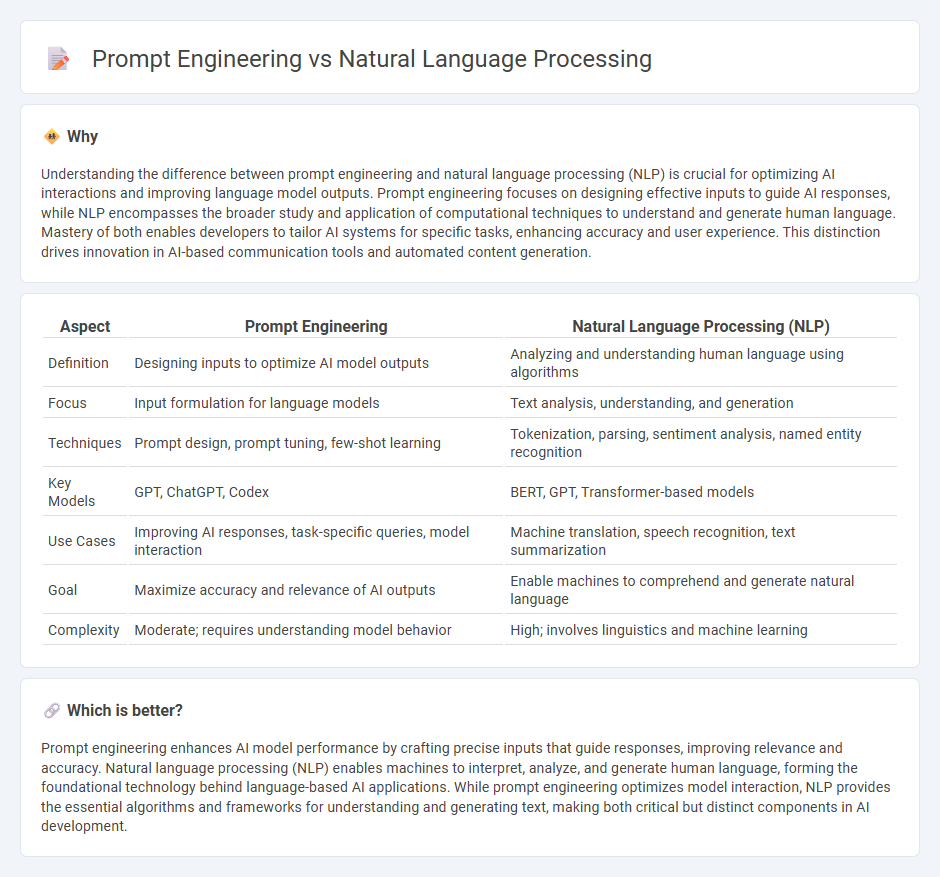
Prompt engineering focuses on designing effective input queries to optimize AI model responses, improving task accuracy and relevance in applications like chatbots and virtual assistants. Natural Language Processing (NLP) encompasses the broader field of enabling machines to understand, interpret, and generate human language through techniques such as tokenization, sentiment analysis, and machine translation. Explore how these technologies intersect to revolutionize human-computer interaction and enhance AI capabilities.
Why it is important
Understanding the difference between prompt engineering and natural language processing (NLP) is crucial for optimizing AI interactions and improving language model outputs. Prompt engineering focuses on designing effective inputs to guide AI responses, while NLP encompasses the broader study and application of computational techniques to understand and generate human language. Mastery of both enables developers to tailor AI systems for specific tasks, enhancing accuracy and user experience. This distinction drives innovation in AI-based communication tools and automated content generation.
Comparison Table
| Aspect | Prompt Engineering | Natural Language Processing (NLP) |
|---|---|---|
| Definition | Designing inputs to optimize AI model outputs | Analyzing and understanding human language using algorithms |
| Focus | Input formulation for language models | Text analysis, understanding, and generation |
| Techniques | Prompt design, prompt tuning, few-shot learning | Tokenization, parsing, sentiment analysis, named entity recognition |
| Key Models | GPT, ChatGPT, Codex | BERT, GPT, Transformer-based models |
| Use Cases | Improving AI responses, task-specific queries, model interaction | Machine translation, speech recognition, text summarization |
| Goal | Maximize accuracy and relevance of AI outputs | Enable machines to comprehend and generate natural language |
| Complexity | Moderate; requires understanding model behavior | High; involves linguistics and machine learning |
Which is better?
Prompt engineering enhances AI model performance by crafting precise inputs that guide responses, improving relevance and accuracy. Natural language processing (NLP) enables machines to interpret, analyze, and generate human language, forming the foundational technology behind language-based AI applications. While prompt engineering optimizes model interaction, NLP provides the essential algorithms and frameworks for understanding and generating text, making both critical but distinct components in AI development.
Connection
Prompt engineering plays a critical role in natural language processing (NLP) by designing effective input queries that optimize the performance of language models like GPT-4. This synergy enhances the accuracy and relevance of text generation, sentiment analysis, and machine translation tasks. Innovations in prompt engineering directly impact the efficiency of NLP applications in chatbots, virtual assistants, and automated content creation.
Key Terms
NLP Algorithms vs. Prompt Design
Natural Language Processing (NLP) algorithms involve computational techniques for analyzing and understanding human language data, including tokenization, parsing, and sentiment analysis to extract meaningful insights. Prompt engineering centers on crafting specific input instructions to optimize the performance of AI language models like GPT, focusing on clarity, context, and structure to elicit desired responses. Explore deeper to understand how these approaches complement each other in advancing AI-driven communication.
Text Corpus vs. Instruction Tuning
Natural language processing (NLP) primarily leverages extensive text corpora to extract patterns, understand syntax, and develop language models that interpret human language. Prompt engineering centers on instruction tuning, refining model responses by optimizing input prompts to guide AI behavior more effectively. Explore the differences and applications between these approaches to enhance your AI language model strategies.
Machine Understanding vs. Output Optimization
Natural Language Processing (NLP) primarily focuses on enabling machines to comprehend, interpret, and generate human language through techniques like syntactic parsing, semantic analysis, and sentiment detection. Prompt engineering, on the other hand, emphasizes crafting precise inputs to optimize the quality and relevance of the output generated by language models, targeting efficiency and specificity in responses. Explore deeper insights to understand how these disciplines complement each other in advancing AI communication capabilities.
Source and External Links
What is Natural Language Processing (NLP)? - TechTarget - NLP enables computers to understand, interpret, and generate human language by analyzing syntax, semantics, and structure, using techniques like parsing, word segmentation, and morphological segmentation.
What is Natural Language Processing? - NLP Explained - AWS - NLP is a machine learning technology that allows computers to interpret, manipulate, and comprehend human language through supervised and unsupervised methods, as well as natural language understanding and generation.
What Is NLP (Natural Language Processing)? - IBM - NLP is a subfield of AI that uses machine learning and computational linguistics to enable computers to recognize, understand, and generate text and speech, powering applications like chatbots, digital assistants, and automated document processing.
 dowidth.com
dowidth.com